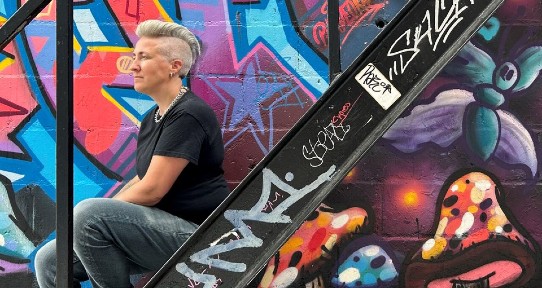Vanier scholar examines community-led safer supply models

University of Victoria Nursing PhD student Nancy Henderson has seen first-hand how access to a safer supply can change the lives of people who use drugs.
After working as a community harm reduction nurse in Ottawa and Toronto for about seven years, Henderson (pictured above) took on a new role in Peterborough. They left front-line nursing to create, lead and research the launch of a prescribed safer supply program intended for 50 participants at a nurse practitioner-led clinic.
Many of the participants reported that access to pharmaceutical-grade medications to replace toxic street drugs was lifesaving—and likely life-changing.
Study finds safer supply offers lifeline
An article about their findings, titled “And this is the life jacket, the lifeline they’ve been wanting”: Participant perspectives on navigating challenges and successes of prescribed safer supply,” was published in March in the journal PLOS ONE.
Fourteen participants from the safer supply program completed interviews and surveys, and from this, 93 per cent reported that they either decreased or stopped using street-acquired fentanyl after joining the program. More than half of participants reported being involved in fewer criminalized activities. And 94 per cent had fewer overdoses.
Overall, Henderson reported program participants felt better, had renewed hope and felt safer.
“Many felt that before joining the safer supply program they had no options left,” Henderson says. “They spoke about being tired of navigating the toxic street supply of drugs that is devastating their community and wanted safer supply prescribing and supports to be available for more people.”
Vanier scholarship to continue research
Henderson will continue researching safer supply as one of four 2024 Vanier Scholars at UVic. The scholarships are valued at $50,000 per year for three years during doctoral studies.
Henderson moved from Ontario to Victoria, after completing a Master of Nursing Science at Queen’s University, for the chance to work with UVic Nursing Professor Bernie Pauly, who is Henderson’s PhD supervisor. Pauly is also a scientist at the Canadian Institute for Substance Use Research (CISUR) and is working on a province-wide study of prescribed safer supply.
The need for safer alternatives to toxic street drugs—a crisis that has killed more than 40,000 Canadians, the equivalent of 21 people a day since 2016—is something Henderson feels passionate about.
Along with their nursing and research knowledge, Henderson can draw on their past lived experience to connect with people who use drugs. Henderson says they want to work collaboratively to challenge discriminatory, stigmatizing and criminalizing policies and systems.
Community-led safer supply models
Now, they want to turn their lens to community-led safer supply. While managing the prescribed safer supply program in Peterborough, Henderson says the small scale and limited capacity of programs, as well as other barriers to joining, such as needing a substance use disorder diagnosis, meant that many people were not able to join.
“We always knew we weren’t reaching everybody,” Henderson says.
“Not everybody who uses drugs has a substance use disorder. There are a lot of people who don’t qualify for these programs and they make up a large proportion of the people who are dying."
Henderson contributed, along with Pauly, to Provincial Health Officer Bonnie Henry’s report to government, called Alternatives to Unregulated Drugs: Another Step in Saving Lives.
In July, Henry released the report and recommended that government expand alternatives to the toxic, unregulated drug supply, which has killed more than 14,000 people in BC since the government declared a public health emergency in 2016.
The report says non-prescribed alternatives to the toxic, unregulated drug supply could take the form of various models, including community-led models such as compassion clubs, co-ops and buyers’ clubs, which were introduced during the HIV/AIDS epidemic to provide lifesaving medications.
Both the BC Coroner and Provincial Health Officer are urging the exploration of community-led models within a regulatory framework, so research will help in understanding what communities need and how they envision these models being implemented.
Need for accessible interventions and innovations
Using community-based participatory research methods, Henderson says they want to explore how such community models could be designed and implemented for a population-level response to the toxic drug crisis.
Henderson says that methadone treatment in the 1960s and ‘70s and supervised injection sites in the early 2000s were introduced in a similar way to safer supply, through pilot projects that created evidence. The same arguments being used nowadays against safer supply—lack of evidence, risk of diversion, increased crime, and creating new substance use disorders—were used against these initiatives then too.
“Despite the historical backlash, methadone is now considered the gold standard treatment for people with opioid use disorder,” they say.
During a public health emergency, Henderson says a variety of accessible interventions and innovations are needed, including safer supply.
“People are dying due to the unregulated and toxic street supply of drugs, which exists because of drug policies based on prohibition and the war on drugs,” Henderson says.
“Safer supply innovations are meant to directly address this toxic drug supply by giving people alternatives, autonomy and choice. This saves lives.”
